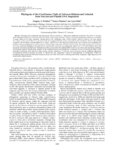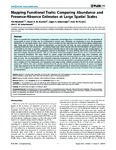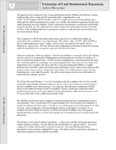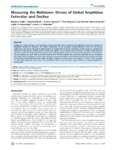|
|
Creator | Title | Description | Subject | Date |
| 1 |
 |
Varner, Johanna M.; Dearing, Maria-Denise | Research data to accompany Varner and Dearing 2014 "Relevant Microclimates and Habitat Suitability" | Data package to accompany "Relevant Microclimates and Habitat Suitability". Package contains a ReadMe file and the following Excel spreadsheets: Elevation Comparison, Moss Transplant Data, Tempdata by site, Variogram-Ambient, Variogram_Ambient Shortrange, Variogram-Surf, Variogram-Talus. | Research data; Relevant microclimates; Habitat suitability | 2014 |
| 2 |
 |
Bohs, Lynn A. | Chloroplast DNA phylogeny of Solanum sect on Las ocarpa | Solanum section Lasiocarpa includes about a dozen species with a center of diversity in the NewWorld tropics. Solanum lasiocarpum and S. repandum (sometimes considered to be conspecific as S. ferox) have an Old World distribution in Asia and the Pacific Islands. Several species in this section produ... | Solanum; trn; Lasiocarpa | 2004 |
| 3 |
 |
Bohs, Lynn A. | Phylogeny of Balsamorhiza and Wyethia (Asteraceae: Heliantheae) using ITS, ETS, and trnK sequence data | Balsamorhiza and Wyethia together comprise 24 species native to western North America. All species in the two genera are perennial herbs with large taproots and chromosome base numbers of x = 19. The species of Balsamorhiza have exclusively basal leaves while the species of Wyethia have cauline leav... | Balsamorhiza; Wyethia; Asteraceae; Engelmanniinae; nuclear ribosomal DNA | 2007 |
| 4 |
 |
Bohs, Lynn A. | Four-gene study of evolutionary relationships in Solanum section Acanthophora | The "spiny solanums," Solanum subgenus Leptostemonum (Solanaceae), comprise a large lineage with over 350 species and include the cultivated eggplant, Solanum melongena. Despite the importance of this subgenus, phylogenetic relationships among these taxa are currently unclear. The present research... | Acanthophora; Granule-bound starch synthase gene; GBSSI; ITS; Internal transcribed spacer; Solanum; trnS-trnG; trnT-trnF; Waxy | 2005 |
| 5 |
 |
Clayton, Dale H.; Rogers, Alan R. | Genetic analysis of lice supports direct contact between modern and archaic humans | Parasites can be used as unique markers to investigate host evolutionary history, independent of host data. Here we show that modern human head lice, Pediculus humanus, are composed of two ancient lineages, whose origin predates modern Homo sapiens by an order of magnitude (ca. 1.18 million years). | Pediculus humanus; Head lice; Molecular phylogeny; Phthirus | 2004 |
| 6 |
 |
Ehleringer, James R. | Bayesian integration of isotope ratio for geographic sourcing of castor beans | Recent years have seen an increase in the forensic interest associated with the poison ricin, which is extracted from the seeds of the Ricinus communis plant. Both light element (C, N, O, and H) and strontium (Sr) isotope ratios have previously been used to associate organic material with geographic... | | 2012-01-01 |
| 7 |
 |
Bohs, Lynn A. | Major clades in Solanum based on ndhF sequence data | Analysis of sequence data from the chloropiast gene ndhF identifies at least 12 major well-supported clades within the genus Solanum. These are briefly described, given informal clade names, and compared with the groups recognized by previous Solanum workers. Non-molecular synapomorphies are propos... | Solanum; ndhF | 2005 |
| 8 |
 |
Bohs, Lynn A. | Phylogenetic relationships among the "spiny solanums" (Solanum subgenus Leptostemonum, Solanaceae) | Species of Solanum subgenus Leptostemonum comprise almost one third of the genus and are distributed worldwide. Members of this group are defined by their sharp epidermal prickles; thus, they are commonly referred to as the ˜spiny solanums." This subgenus includes a number of economically important... | Granule-bound starch synthase gene; GBSSI; Heterandry; ITS; Leptostemonum; Solanum; trnS-trnG; Waxy | 2006 |
| 9 |
 |
Bohs, Lynn A. | Phylogeny of the carolinense clade of solanum (Solanaceae) inferred from nuclear and plastid DNA sequences | The large and economically important genus Solanum contains ca. 1,400 species distributed worldwide. One of the 12-14 major clades identified in the genus is the Leptostemonum clade, or the "spiny solanums." Previous molecular phylogenetic studies have identified 14 major clades in the spiny solanum... | | 2014-01-01 |
| 10 |
 |
Bohs, Lynn A. | Phylogenetic relationships in Solanum (Solanaceae) based on ndhF sequences | A phylogenetic analysis was conducted using sequence data from the chloroplast gene ndhF. Sequences were obtained from 25 species of Solanaceae, including 18 species of Solanum representing five of the seven conventionally recognized subgenera. | Solanum; ndhF | 1997 |
| 11 |
 |
Gesteland, Raymond F.; Atkins, John F.; Felden, Brice; McCutcheon, John P. | Probing the structure of the Escherichia coli 10Sa RNA (tmRNA) | The conformation of the Escherichia coli 10Sa RNA (tmRNA) in solution was investigated using chemical and enzymatic probes. Single- and double-stranded domains were identified by hydrolysis of tmRNA in imidazole buffer and by lead(II)-induced cleavages. Ribonucleases T1 and S1 were used to map unpai... | Covariation; Pseudoknot; Structural Probing; 10Sa RNA; tmRNA | 1997 |
| 12 |
 |
Rogers, Alan R. | How much can fossils tell us about regional continuity? | Presents a study on the genetic contribution of earlier populations to later populations within regions called regional continuity. Testing for regional continuity with multiple characters; Replacement of archaic population by a population of modern humans. | Human genetics; Fossils; Regional continuity | 2006-06-05 |
| 13 |
 |
Bohs, Lynn A. | Three-gene phylogeny of the genus Solanum (Solanaceae) | Solanum, with approximately 1,500 species, is the largest genus in the Solanaceae and includes economically important species such as the tomato, potato, and eggplant. In part due to its large size and tropical center of diversity, resolving evolutionary relationships across Solanum as a whole has ... | ndhF; trnT-F; Waxy; Solanum; Cyphomandra | 2007 |
| 14 |
 |
Sekercioglu, Cagan | Mapping functional traits: comparing bundance and presence-absence estimates at large spatial scales | Efforts to quantify the composition of biological communities increasingly focus on functional traits. The composition of communities in terms of traits can be summarized in several ways. Ecologists are beginning to map the geographic distribution of trait-based metrics from various sources of data,... | | 2012-01-01 |
| 15 |
 |
Adler, Frederick R.; Jackson, Brian Richard; Carroll, Karen C.; Samore, Matthew H. | Use of strain typing data to estimate bacterial transmission rates in healthcare settings | OBJECTIVE: To create an affordable and accurate method for continuously monitoring bacterial transmission rates in healthcare settings. DESIGN: We present a discrete simulation model that relies on the relationship between in-hospital transmission rates and strain diversity. We also present a proof... | Strain typing; Infection control; Transmission model | 2005 |
| 16 |
 |
Dearing, Maria-Denise | [Dearing_Database_Pilot] | [Database deposited March 08, 2013, as part of a pilot project, eResearch Committee, University of Utah.] [This description should include information that explains the dataset in detail in a manner that would be useful to potential reuse. The contact information for the primary investigator should ... | [Creator keywords here.] | 2013-03-08 |
| 17 |
 |
Bohs, Lynn A. | Solanum phylogeny inferred from chloroplast DNA sequence data | A data set derived from gene sequences of ndhF is used to deduce phylogenetic relationships among the subgenera of Solanum, among related genera of the tribe Solaneae, and within selected Solanum clades. Complete ndhF sequences were obtained for 12 species o f Solanum, representing five of the seve... | Solanum; Capsicum; Cyphomandra; Lycopersicon; Datura; Jaltomata; Nicotiana; Physalis; ndhF; Chloroplast DNA | 1999 |
| 18 |
 |
Bohs, Lynn A. | Phylogeny and provisional classification of the Solanaceae based on chloroplast DNA | A phylogenetic analysis of the Solanaceae based on chloroplast DNA variation is presented. Restriction site maps were determined for 79 species (52 genera) for 11 restriction enzymes. | rbcL; ndhF; Chloroplast DNA | 1999 |
| 19 |
 |
Clayton, Dale H. | Testing species limits of non-echolocating Philippine swiftlets (Collocalia spp.) using molecular genetic data | Swiftlets are small, insectivorous birds that are distributed from the Indian Ocean, through southeast Asia and north Australia, to the Pacific. About 22 species of swiflets nest in caves or other dark places, where they navigate using a crude form of echolocation (Chantler and Driessens 1995). Thr... | | 2000 |
| 20 |
 |
Adler, Frederick R. | Role of heterogeneity in the persistence and prevalence of sin nombre virus in deer mice | Many diseases persist at a relatively low prevalence, seemingly close to extinction. For a chronic disease in a homogeneous population, reducing the transmission rate by a fraction proportional to the prevalence would be sufficient to eradicate the disease. This study examines how higher prevalence ... | Transmission; Survivorship; Seropositivity | 2008 |
| 21 |
 |
Adler, Frederick R. | Reply: | We appreciate the comments of Drs. Craig and Simpson and Drs. Mullins and Schwartz, and the challenge they raise to make MALD more believable, comprehensible, and usable. Acetaminophen (APAP) toxicity is indeed a complex process involving multiple steps. Although the underlying mathematics is more i... | | 2012-01-01 |
| 22 |
 |
Bohs, Lynn A. | Phylogeny of the Cyphomandra clade of the genus Solanum (Solanaceae) based on ITS sequence data | 13 major clades can be recognized within the genus Solatium (Solanaceae) based on chloroplast DNA sequence data. One of these is the Cyphomandra clade, which includes about 50 neotropical species. These have traditionally been placed into two or three sections: S. section Pachyphylla (formerly recog... | Cyphomandra; ITS; osmophores; self-incompatibility; Solanum | 2007 |
| 23 |
 |
Adler, Frederick R.; Liou, Theodore G.; Cahill, Barbara C. | Lung transplantation and survival in children with cystic fibrosis | The effects of lung transplantation on the survival and quality of life in children with cystic fibrosis are uncertain. We used data from the U.S. Cystic Fibrosis Foundation Patient Registry and from the Organ Procurement and Transplantation Network to identify children with cystic fibrosis who were... | Life; Infection; Risk; Harm | 2007 |
| 24 |
 |
Sekercioglu, Cagan | Measuring the meltdown: drivers of global amphibian extinction and decline | Habitat loss, climate change, over-exploitation, disease and other factors have been hypothesised in the global decline of amphibian biodiversity. However, the relative importance of and synergies among different drivers are still poorly understood. We present the largest global analysis of roughly ... | | 2008-01-01 |
| 25 |
 |
Goller, Franz | Experimental support for a model of birdsong production | In this work we present an experimental validation of a recently proposed model for the production of birdsongs. We have previously observed that driving the model with simple functions of time, which represent tensions in vocal muscles, produces a wide variety of sounds resembling birdsongs. In th... | Vocal; Muscles; Syrinx | 2003 |

























